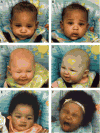The Relationship between Infant Facial Expressions and Food Acceptance
- PMID: 28674639
- PMCID: PMC5492973
- DOI: 10.1007/s13668-017-0205-y
The Relationship between Infant Facial Expressions and Food Acceptance
Abstract
Purpose of review: To highlight the range of methodological approaches used to objectively measure hedonic responses to taste stimuli during the first year of life and how these behavioral responses change with experience. Challenges inherent to this type of research are discussed.
Recent findings: Although newborns display characteristic orofacial reactivity to four of the five basic tastes, the facial expressions made and the amount of food consumed can be modified by experience: children learn to like what they are fed. In some cases changes in facial responses are concordant with infant consumption, whereas in other cases facial reactivity follows changes in intake.
Summary: Together with ingestive measurements, precise and objective measurements of orofacial reactivity provide an understanding of how early experiences shift the hedonic tone of the taste of foods, the foundation of dietary preferences.
Keywords: distaste; facial expressions; flavor; liking; pleasure; taste.
Conflict of interest statement
Conflict of Interest Catherine A. Forestell and Julie A. Mennella declare they have no conflict of interest.
Figures

Similar articles
-
Developmental changes in the acceptance of the five basic tastes in the first year of life.Br J Nutr. 2009 Nov;102(9):1375-85. doi: 10.1017/S0007114509990286. Epub 2009 Jun 9. Br J Nutr. 2009. PMID: 19505346
-
Differential facial responses to four basic tastes in newborns.Child Dev. 1988 Dec;59(6):1555-68. Child Dev. 1988. PMID: 3208567
-
Orofacial reactivity to the sight and smell of food stimuli. Evidence for anticipatory liking related to food reward cues in overweight children.Appetite. 2012 Apr;58(2):508-16. doi: 10.1016/j.appet.2011.12.018. Epub 2012 Jan 4. Appetite. 2012. PMID: 22245131
-
Perception and hedonic value of basic tastes in domestic ruminants.Physiol Behav. 2011 Oct 24;104(5):666-74. doi: 10.1016/j.physbeh.2011.07.011. Epub 2011 Jul 28. Physiol Behav. 2011. PMID: 21798275 Review.
-
Role of parents in the determination of the food preferences of children and the development of obesity.Int J Obes Relat Metab Disord. 2004 Jul;28(7):858-69. doi: 10.1038/sj.ijo.0802532. Int J Obes Relat Metab Disord. 2004. PMID: 15170463 Review.
Cited by
-
Use of baby food products during the complementary feeding period: What factors drive parents' choice of products?Matern Child Nutr. 2024 Oct;20(4):e13689. doi: 10.1111/mcn.13689. Epub 2024 Jun 19. Matern Child Nutr. 2024. PMID: 38898599 Free PMC article.
-
Infant and Toddler Responses to Bitter-Tasting Novel Vegetables: Findings from the Good Tastes Study.J Nutr. 2021 Oct 1;151(10):3240-3252. doi: 10.1093/jn/nxab198. J Nutr. 2021. PMID: 34191021 Free PMC article.
-
Changes in food valence of regular diet depending on the experience of high and low preference food.Neuropsychopharmacol Rep. 2024 Dec;44(4):842-846. doi: 10.1002/npr2.12481. Epub 2024 Oct 28. Neuropsychopharmacol Rep. 2024. PMID: 39467301 Free PMC article.
-
Infant and Toddler Consumption of Sweetened and Unsweetened Lipid Nutrient Supplements After 2-Week Home Repeated Exposures.J Nutr. 2021 Sep 4;151(9):2825-2834. doi: 10.1093/jn/nxab148. J Nutr. 2021. PMID: 34036363 Free PMC article. Clinical Trial.
-
Fetal Alcohol Programming of Subsequent Alcohol Affinity: A Review Based on Preclinical, Clinical and Epidemiological Studies.Front Behav Neurosci. 2020 Mar 10;14:33. doi: 10.3389/fnbeh.2020.00033. eCollection 2020. Front Behav Neurosci. 2020. PMID: 32210775 Free PMC article. Review.
References
-
- Darwin C. The expression of the emotions in man and animals. Oxford, UK: Harper Collins/Oxford University Press; 1998. originally published in 1872.
-
- Fridlund AJ, Gilbert AN, Izard CE, Burdett AN. Emotions and facial expression. Science. 1985;230(4726):607–8. - PubMed
-
- Ekman P, Friesen WV. Constants across cultures in the face and emotion. J Pers Soc Psychol. 1971;17(2):124–9. - PubMed
-
- Ekman P, Rosenberg EL. What the face reveals: Basic and applied studies of spontaneous expression using the Facial Action Coding System (FACS) New York: Oxford University Press; 1997.
-
- Masson JL, Patwardhan MV. Aesthetic rapture: the rasadhyaya of the natasastra. Pune, India: Deccan College; 1970.
Grants and funding
LinkOut - more resources
Full Text Sources
Other Literature Sources
Research Materials
